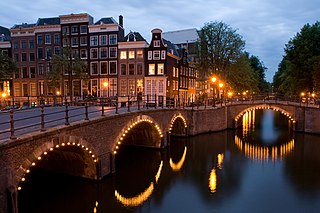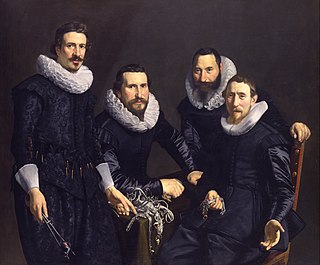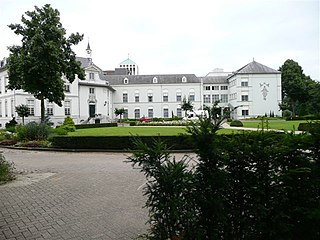
Amsterdam is the capital and most populous city of the Netherlands, with The Hague being the seat of government. It has a population of 921,402 within the city proper, 1,457,018 in the urban area and 2,480,394 in the metropolitan area. Located in the Dutch province of North Holland, Amsterdam is colloquially referred to as the "Venice of the North", for its large number of canals, now designated a UNESCO World Heritage Site.

Gerrit Rietveld was a Dutch furniture designer and architect.

Utrecht is the fourth-largest city and a municipality of the Netherlands, capital and most populous city of the province of Utrecht. It is located in the eastern corner of the Randstad conurbation, in the very centre of mainland Netherlands. It has a population of 361,699 as of December 2021.

Enschede is a municipality and city in the eastern Netherlands in the province of Overijssel and in the Twente region. The eastern parts of the urban area reaches the border of the German city of Gronau.

Amersfoort is a city and municipality in the province of Utrecht, Netherlands. As of 31 January 2023, the municipality had a population of 160,902, making it the second-largest of the province and fifteenth-largest of the country. Amersfoort is also one of the largest Dutch railway junctions with its three stations—Amersfoort Centraal, Schothorst and Vathorst—due to its location on two of the Netherlands' main east to west and north to south railway lines. The city was used during the 1928 Summer Olympics as a venue for the modern pentathlon events. Amersfoort marked its 750th anniversary as a city in 2009.

Weesp is a city, an urban area in the municipality of Amsterdam and a former municipality in the province of North Holland, Netherlands. It had a population of 20,445 in 2021. It lies on the river Vecht and next to the Amsterdam–Rhine Canal in an area called the Vechtstreek.

Jan Weenix or Joannis Wenix was a Dutch painter. He was trained by his father, Jan Baptist Weenix, together with his cousin Melchior d'Hondecoeter. Like his father, he painted various subjects, but is mostly known for his paintings of dead game and hunting scenes. Many paintings in this genre were formerly ascribed to the elder Weenix, but are now generally considered to be the work of the son.

Thomas de Keyser was a Dutch portrait painter and a dealer in Belgium bluestone and stone mason. He was the most in-demand portrait painter in the Netherlands until the 1630s, when Rembrandt eclipsed him in popularity. Rembrandt was influenced by his work, and many of de Keyser's paintings were later falsely attributed to Rembrandt.

The Hague School is a group of artists who lived and worked in The Hague between 1860 and 1890. Their work was heavily influenced by the realist painters of the French Barbizon school. The painters of the Hague school generally made use of relatively somber colors, which is why the Hague School is sometimes called the Gray School.

Hendrick Jansz ter Brugghen was a Dutch painter of genre scenes and religious subjects. He was one of the Dutch followers of Caravaggio – the so-called Utrecht Caravaggisti. Along with Gerrit van Hondhorst and Dirck van Baburen, Ter Brugghen was one of the most important Dutch painters to have been influenced by Caravaggio.

Roelant Savery was a Flanders-born Dutch Golden Age painter.

Amsterdam-Noord is a borough of Amsterdam, Netherlands with a population of about 90,000. The IJ, the body of water which separates it from Amsterdam-Centrum and the rest of the city, is situated southwest of Amsterdam-Noord. The borough, which has an area of 49.01 km2, borders the municipalities of Zaanstad, Oostzaan, Landsmeer and Waterland to the north, all part of the province of North Holland like Amsterdam. It borders the Markermeer to the east.

The Centraal Museum is the main museum in Utrecht, Netherlands, founded in 1838. The museum has a wide-ranging collection, mainly of works produced locally. The collection of the paintings by the Northern Mannerist Joachim Wtewael is by a long way the largest anywhere in the world. Other highlights are many significant paintings by the Utrecht Caravaggisti, such as Gerard van Honthorst and Hendrick ter Brugghen. Both of them travelled to Rome in the early 17th century to study the works of the Italian master Caravaggio. In the previous generation, as well as Wtewael, Abraham Bloemaert and the portraitist Paulus Moreelse were the most significant Utrecht painters, with Jan van Scorel still earlier.

Lambertus Reiner "Reinbert" de Leeuw was a Dutch conductor, pianist and composer.

Lambertus Johannes Hansen was a 19th-century Dutch painter.

Petronella Oortman was a Dutch woman whose elaborate dollhouse is part of the permanent collection of the Rijksmuseum in Amsterdam.

Van Gogh House is a cultural site in Nieuw-Amsterdam, in the province of Drenthe in the Netherlands. The painter Vincent van Gogh stayed here for two months in 1883; the house is now a museum.

Boxmeer Castle is an originally 13th century castle in Boxmeer, North-Brabant, Netherlands. It is situated on a former island in the Meuse.



















